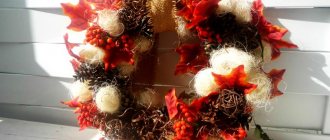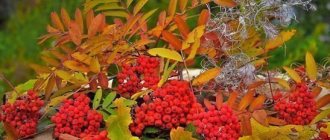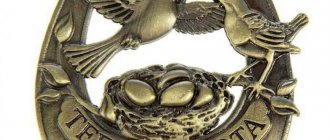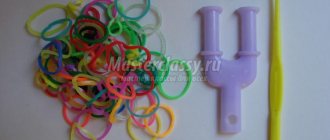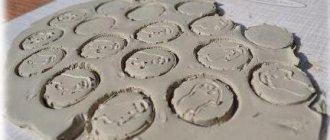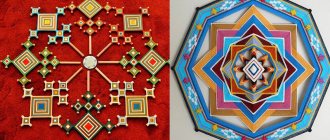Needlework
07/20/2018 Anastasia Prozheva
Needlewomen strive to capture the bright natural colors in their creative works. The symbol of autumn compositions is often the rowan tree. The intense combination of its green leaves and red-orange berries is used in products as decoration or as a whole composition. At the same time, a rowan branch is made with your own hands in absolutely different variations, depending on the purpose of the product.
A bright beaded topiary is perfect as an interior item. Colorful work will bring a fresh touch to a dull room. The work is quite labor-intensive, but you can master it by following the step-by-step instructions.
candy tree
Due to the light shine of the beads, the tree acquires the effect of a varnish coating. In this case, the reflection is associated with the natural phenomenon of wet foliage, which is observed on trees in rainy autumn.
The product consists of several rowan branches. Therefore, having dealt with one element of the tree, you can create a whole composition in a similar way.
Involved in weaving:
- Czech beads No. 10 green and orange;
- copper and green wire;
- brown ribbon;
- brown acrylic paint;
- gypsum.
Beads are strung on copper wire 10-12 cm long and twisted. You should start working by moving the bead to one end of the wire.
After 5 mm from the first bead, the second one is strung and twisted again.
The entire row of beads continues along the length of the wire in a similar manner. A rowan bunch requires about 15 beads.
The ends of the wire are twisted together to form an inflorescence.
In order to make a full-fledged bunch, you should prepare 5 such inflorescences.
The inflorescences are connected into a single piece by twisting the wire. When the rowan bunches are ready, work moves on to the leaves.
Beads of the corresponding color are strung on a green wire 10 cm long.
It is located in the center of the segment. One of the ends of the wire passes through the bead again and the wire is tightened. The next two beads are threaded in the same way, then three, then four.
Related article: Braid of 12 loops with knitting needles with diagrams and description
After this, the number of beads decreases one by one until there is only one bead left in the row. Then the ends of the wire are twisted.
Several leaves of beads are made, after which a single branch is formed. In this case, the rest are screwed perpendicularly to one leaf.
When the required number of branches from leaves and berry clusters has been prepared, the random formation of rowan branches begins. In this case, the clusters and leaves are twisted together in the desired order.
To create a tree, you should take part of the modeling mass and roll it into a column. You need to insert prepared rowan branches into it one by one.
After the mass has dried, the tree trunk is wrapped with brown tape, as in the photo.
The tree is inserted into a small flower pot and filled with plaster.
When the plaster dries, it should be painted brown.
Notes on sculpting “Rowan Brush”
Rowan Brush
Sculpting lesson notes
Goals:
1. Teach children to knead and smear plasticine on cardboard to create the necessary background for the composition
2. Learn to roll out plasticine to create berries, branches or rowan leaves
3.Develop fine motor skills of the hand
Materials for the lesson:
A rowan branch, modeling boards, plasticine of different colors, a sheet of cardboard.
Progress of the lesson
Educator: Look, guys, what a beautiful branch is in the vase. What tree is this branch from? Of course, rowan. We can easily recognize rowan by its patterned leaves and clusters of berries that turn red in the fall. Rowan berries are considered autumn berries because they ripen in late autumn. Rowan berries are removed from the tree only after the first frost. The taste of rowan is bitter. But it makes very tasty jam. On those rowan trees that grow in the forest, the berries remain until winter. Birds and squirrels love to eat mountain ash.
Today I suggest you make a sprig of rowan berries with a bunch of berries from plasticine. But we will not sculpt a sculpture, but a bas-relief - a “picture” from plasticine.
For this we need sheets of hard cardboard. First we will make a background from plasticine on them. To do this, you need to warm it up well in your palms, knead it, and then carefully spread it over the plate. Let's think about which background color is best to choose. It is necessary that the rowan branch is clearly visible on it. This means that the background color should contrast with the red color of the berries, the brown color of the twig, and the green leaves. What could he be like? Yellow, blue, light blue, black. Try to ensure that the plasticine lays on the cardboard in an even layer.
Did everyone succeed? Now let's start drawing the twig. We make the branch in the shape of a thin flagellum, carefully apply it to the background, pressing lightly so that the branch does not flatten, but remains thin and convex.
We do the same with the green rowan leaf. Look again at the shape of the leaf.
Now the most important part is the bunch of rowan berries. We attach the berries in the form of small balls to the background and press them lightly.
Look what expressive paintings we made! Let's try to imagine what rowan thinks about when the berries ripen. Whether she is happy or not. What does a tree experience when a mischievous boy climbs its trunk and branches, wanting to pick a lot of berries? Delpet does this not for anyone’s benefit, but for his own amusement, and when he’s had enough of playing, he throws broken branches. It must be sad and painful for the mountain ash when people do this.
So that you remember that any tree, any plant is also a living being that is in pain, bad, we will leave our branches at the exhibition in the group.
Plasticine berries
The rowan branch also inspires little creators. Often it acts as a craft for the autumn holiday. As a rule, plasticine is involved in such work.
To create a rowan branch from plasticine, you should stock up on material in the appropriate colors and a base in the form of a cardboard sheet.
Brown plasticine branches are formed and randomly attached to the base.
Small balls are rolled out of red-orange plasticine, each of which is equipped with a black or brown center characteristic of berries. The balls are arranged on the base in the form of a cluster.
Cuts are made on each core to give the berries a natural appearance.
Leaves are formed from green and orange plasticine. They are located along the prepared branches.
Alternately, natural veins are drawn on the leaves.
The craft is ready!
We sculpt a rowan branch with our own hands from plasticine in MK
Plasticine is an excellent material for modeling enthusiasts. Children especially love to sculpt something from plasticine. Making a rowan brush from plasticine with your own hands is very simple; for this we need very little material:
- Plasticine black, black, orange, green, brown;
- Scalpel or plasticine knife;
- Modeling board;
Instead of a board, the basis can be a sheet of colored cardboard. You need to take a piece of brown plasticine and roll it into a rod of arbitrary length, up to half a centimeter thick, this will be the basis for the twig. We cut the workpiece into any number of branches and branches, you can make 2-4 pieces, on one side we make an end converging into a thin line. Then we mold the blanks in the shape of a twig onto the base.
Let's start sculpting rowan berries. We tear the orange plasticine into small pieces and roll into pea-sized balls, about 10 pieces. You need to glue a small black or brown dot to each berry. To make the berries look like real ones, you need to make small cuts or scratches at each point.
We sculpt the leaves from green and yellow plasticine, you can also add a few orange ones. The leaves should not be too large; after you cut out several leaves from a block of plasticine, you should give them a design; this can be done perfectly with a toothpick
The finished composition should be similar to the one shown in the photo.
Autumn in knitting
Rowan motifs can also be seen in knitted items. As a decoration for your headdress, you can create an original element in the form of a rowan branch crocheted.
For the leaves you should cast on a dozen air loops.
Related article: Knitting for newborns: blanket, hat, booties, blouse + photo
Knitting continues in the opposite direction.
Half-loops are created along the chain.
Then they close.
After yarn over, the hook is pulled through three loops at once. Then yarn over again and cast off the next three stitches.
And so on until one loop remains.
The work is turning around. Half-loops are formed along the entire row, after which they are closed three at a time.
The row ends with a connecting post and the thread is cut.
This is how all the leaves are done. The berries begin with four air loops closed into a ring.
Single crochets are made in a circle through the central ring.
The rows do not close during operation. You should get a dense berry.
The product is turned on the wrong side. The wrong side will be the front side of the work.
The blanks are fixed to the main product in parts or after preliminary assembly.
Crochet rowan with diagrams and job description
I would like to share a diagram of a rowan brush for a crochet hook.
The leaf is knitted according to this pattern.
- Cast on 10 air loops (VP) in the chain.
- Next we knit in the back loop, insert the hook into the second loop and pull it out.
- Yarn over.
- Insert the hook into the next back half loop and pull out the loop. There will be two loops on the hook.
- Yarn over to the end of the chain and pull out a loop in the next back half loop. There should be a total of 18 loops on the hook.
- We close the loops. We make a yarn over. Pull the yarn through the first three loops in one go.
- After yarn over, pull the thread through the next three loops again. Repeat until there are 4 loops left on the hook.
- Yarn over three loops; there will now be 2 loops on the hook.
- Yarn over and pull the thread through the remaining 2 loops, the row is closed, and 1 loop remains on the hook.
- After this, the second side is knitted, the knitting is turned to the other side and knitted on the opposite side with a chain of air loops, each time inserting the hook into the remaining half-loop
- Insert the hook into the second loop from it, pull it out and yarn over.
- Pull out the next loop, leaving four loops on the hook.
- Repeat until the end of the chain.
- Closing the loops. Yarn over Pull the thread through three loops at a time. Repeat yarn over and pull through. Until there are four loops left.
- Yarn over Pull through three loops, two remain.
- Yarn over, pull through two.
The second side of the leaf is also ready.
There is also a scheme for berries:
- Cast on a chain of 4 chain stitches, then close into a SS circle.
- 8 single crochets in a ring. Do not close the circular row SS.
- Continue sc over completed row.
- Insert the hook into the ring each time.
- In total, perform 44 single crochets in the round.
- Single crochets will be placed on top of each other, tie tightly and form a berry.
- Break the thread and unroll the work. The wrong side of the knitting is the front side for the berry.
By making several berries and leaves in this way, you can form a crocheted composition.
